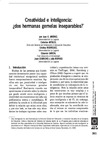Identificador persistente para citar o vincular este elemento:
https://accedacris.ulpgc.es/handle/10553/73153
| Título: | Creativity and intelligence: Two twin-inseparable sisters? | Autores/as: | Jimenez, Juan E. Artiles, Ceferino Rodriguez, Cristina Garcia, Eduardo Camacho, Juan Moraes, Julia |
Clasificación UNESCO: | 58 Pedagogía | Palabras clave: | Thinking Creativity Intelligence Figure Creativity Verbal Creativity, et al. |
Fecha de publicación: | 2008 | Publicación seriada: | Revista Española de Pedagogía | Conferencia: | 17th Biannual Conference of the World Council for Gifted and Talented Children | Resumen: | The study here presented has been carried out within context of the Program for the attention of high ability students of Canary Islands. The aim was to analyze the existent relationship between creativity and intelligence studying the figure and verbal creativity among different profiles of students with high ability and non exceptional students. For this purpose, we selected a sample of 634 students from 1 degrees to 6 degrees of Primary grades from different areas (urban and rural) of the islands of Gran Canaria and Tenerife. They were administered the Battery of Differential and General Aptitudes (BADyG, Yuste, 1992), the adaptation of the Test of Creative Thought of Torrance (TTCT, Torrance, 1974) and the Test of Evaluation of the Verbal Creativity (PVEC-4) both adapted tests and standardized for the Canarian school population. In a first phase, the students were classified in function of different profiles of intellectual exceptionality defined in the own legislation of the Autonomous Community of Canary Islands (BOCA, 2002) (gifted, academic talent, simple talent, mixed talents) and non exceptional students. The results showed that as much the gifted as the creative talents are characterized by a bigger creativity in comparison to the students that didn't present high capacities. Also, it was found that the figurative dimension of the creativity was more associated to the profile of giftedness, while in the case of the creative talent it was the verbal creativity. El trabajo que aquí se presenta se ha realizado en el contexto del Programa para la atención al alumnado con altas capacidades intelectuales de Canarias. El principal objetivo de la investigación ha sido estudiar la relación existente entre creatividad e inteligencia analizando la creatividad figurativa y verbal entre distintos perfiles de alumnos con altas capacidades y alumnos que no presentan esa condición. Para ello se seleccionó a una muestra de 634 alumnos de 1º a 6º de Primaria procedentes de distintas zonas (urbanas y rurales) de las islas de Gran Canaria y Tenerife. Se les administró la Batería de Aptitudes Diferenciales y Generales (BADyG, Yuste, 1992), la adaptación del Test de Pensamiento Creativo de Torrance (TTCT, Torrance, 1974) y la Prueba de Evaluación de la Creatividad Verbal (PVEC-4) ambas pruebas adaptadas y baremadas para la población escolar canaria. En una primera fase, los sujetos fueron clasificados en función de distintos perfiles de excepcionalidad intelectual definidos en la propia legislación de la Comunidad Autónoma de Canarias (BOCA, 2002) (i.e., superdotado, sobredotación intelectual, talento académico, talento simple, talento mixto) y alumnos que no presentaban alta capacidad intelectual. Los resultados mostraron que tanto los superdotados como los talentos creativos se caracterizan por una mayor creatividad en comparación a los alumnos que no presentaban altas capacidades. Asimismo, se encontró que la dimensión figurativa de la creatividad estaba más asociada al perfil de superdotación intelectual, mientras que en el caso del talento creativo lo estaba la creatividad verbal. |
URI: | https://accedacris.ulpgc.es/handle/10553/73153 | ISSN: | 0034-9461 | Fuente: | Revista Espanola De Pedagogia [ISSN 0034-9461],v. 66 (240), p. 261-282, (Mayo-Agosto 2008) |
| Colección: | Artículos |
Citas SCOPUSTM
9
actualizado el 08-jun-2025
Citas de WEB OF SCIENCETM
Citations
7
actualizado el 25-feb-2024
Visitas
146
actualizado el 28-dic-2024
Descargas
77
actualizado el 28-dic-2024
Google ScholarTM
Verifica
Comparte
Exporta metadatos
Los elementos en ULPGC accedaCRIS están protegidos por derechos de autor con todos los derechos reservados, a menos que se indique lo contrario.
